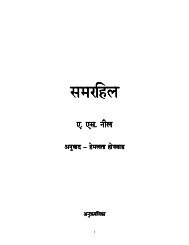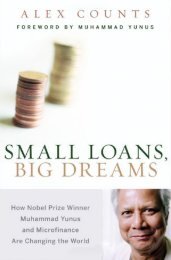toy treasures - arvind gupta (60 kb doc)
toy treasures - arvind gupta (60 kb doc)
toy treasures - arvind gupta (60 kb doc)
You also want an ePaper? Increase the reach of your titles
YUMPU automatically turns print PDFs into web optimized ePapers that Google loves.
STUNT PLANEWhen you chuck this fascinatingplane it will take a round and comeback to you.So, you can chuck it with one handand catch it with the other.Take a 15-cm square of thin butstrong paper.Glazed newspaper will do very well.Fold the paper in half from thebottom to the top Fig (1).Fold it in half from side to sideFig (2).Press the paper flat Fig (3).Unfold it again Fig (4).Now fold the top edge to meet thecenterfold line Fig (5).Fold the right side edge down to meetthe centerline Fig (6).Then fold it down again to meet thecenter of the paper Fig (7).Repeat the process on the left sideedge Fig (8).Fold the top point backward to meetthe centerline Fig (9).Now fold the paper into half fromside to side Fig (10).
STUNT PLANECONTINUEDFold down the top wing so that it meetsthe side edge Fig (11).Fold the bottom wing in just the sameway Fig (12).Unfold the wings again.Fold up the tail section.The picture shows you where the foldline starts and ends Fig (13).Press the tail flat and unfold it againFig (14).Push the tail section inside itself alongthe fold line Fig (15).Fig (16, 17) shows this process in moredetail.Fold the wings down again and openthem out.Shape the wings by curling the bottomedge upwards Fig (18).To loop the loop, hold the plane withits nose pointing upwards and with theunderside facing you Fig (19).Throw the plane smoothly upwards.It should loop away from you and thencome back Fig (20).So, have great fun throwing it with onehand and catching it with the other.You can make this plane performseveral other stunts and tricks.
LOOP GLIDERFor the best performance you must fly theloop glider in a big room where the air isstill.For making the loop glider you will needscissors, a sheet of bond paper, ruler,pencil, a plastic soda straw and somesticky tape Fig (1).Cut two strips of paper, one measuring2-cm x 16-cm and the other 2-cm x 10-cmFig (2).Cut the plastic soda straw so that it is15-cm long Fig (3).Bend the small strip into a loop so that itsends slightly overlap.Tape the overlapping ends together.Repeat this step with the large stripFig (4).Instead of sticky tape you can use anygood adhesive.With a piece of sticky tape attach thesmall loop to one end of the soda strawFig (5).Attach the larger loop to the opposite endFig (6).The glider is now ready for a take-off.To fly the loop glider, hold it high withthe small loop in the front and throwgently Fig (7).The loop glider will glide through the air,losing height slowly.If the loop glider wobbles about thenadjust the position of the loops.See what happens when you fly the loopglider with the large loop in the front.
FLYING FISHThis is the simplest and the most amazingflying object that you can make.The flying fish will twist and turn roundand round.To make it all you will require is a sheet ofpaper (old newspaper will do well) and ascissors Fig (1).Cut a long strip of paper about 2-cm wideFig (2).Place the strip in a horizontal position.On the lower right-hand side, cut a slit halfway across the strip.Repeat on the upper left-hand side Fig (3).Bring the right-hand slit over to meet theleft-hand slit Fig (4).Slip both the slits into each other so thatthey are interlocked together Fig (5).This is what your completed flying fishwould look like Fig (6).Throw the flying fish high up in the air andit will twist and turn around on its way tothe ground Fig (7).Try making flying fishes of various sizesand coolers.
PULLBACK CARMr. K.V.S. Kartha - an activemember of the Kerala Sastra SahityaParishad (KSSP), devised this verydelightful car.On being pulled back this car storesenergy.On leaving it - this energy is releasedand the car dashes forwards.Take a small plastic soap case andmake four holes in it with a dividerpoint as shown in Fig (1).Heat the tip of a long needle Fig (2)and poke it in the center of a cheapquality plastic button Fig (3).Put two such button and needleassemblies in the holes of the soapcase.Heat the eye end of the needles andaffix one button each Fig (4).The buttons become the wheels andthe needles become axles.Now tie some sewing thread on thethin end of a 20-cm long broomstickFig (5).Tape or tie the broomstick well to theside of the soap case.Tie the other end of the thread to theneedle of the front wheels Fig (6).Now keep the car on the ground andpull it back.You can see the thread rolling up onthe needle axle.This results in the broomstick bowingdown and storing energy Fig (7).On releasing the car the storedenergy in the broomstick propels thecar forwards Fig (8).
TWIN TURBINESBoth these turbines work very well andare very easy to make.Take the plastic lid of any round tin.A pan masala tin lid is ideal Fig (1).Mark out six equally spaced lines on itsrim.Cut these lines and about 1 cm. of theperimeter Fig (2).Offset the cut portions to make theblades of the turbine.Make a hole in the center of the lid andpress fit a 2-cm long piece of used ballpen refill in it Fig (3).Put a long needle inside the refill bush tocomplete the turbine Fig (4).Hold the turbine under a water streamand see it spin Fig (5).For the second turbine take the outercover of a cigarette pack Fig (6).Cut it into half its length Fig (7).Using the existing creases fold threeequally spaced blades.Trim the blades into equal size and stickthem Fig (8).Affix a 6-cm long used ball pen refillthrough the center using some glueFig (9).Put a long needle through the refill forthe axle Fig (10).Hold the two ends of the needle andblow or else keep the turbine under astream of water and see it spin Fig (11).
MAGIC WINDMILLThis windmill is essentially a propelleron a notched stick. Its working haspuzzled and baffled people for over acentury.Take a 25-cm long reed stick, or even aused sketch pen or a pencil with arubber on one end will do.Cut 5-6 notches on it using a knife or atriangular file Fig (1).The notched stick is shown in Fig (2).The ice-cream stick (an old ball penrefill is better) shown in Fig (3) is usedto stroke the notches.Make a small propeller about 3-cm longfrom another ice-cream stick (or thickcard sheet) Fig (4).Put a loose pin or nail through thepropeller hole and fix it at the end of thenotched stick Fig (5).Holding your forefinger on the far sideof the notched stick and your thumb onthe near side, stroke the ice-cream stic<strong>kb</strong>ack and forth on the notches.The propeller will turn in one directionFig (6).Now loosen your forefinger and let yourthumb press against the stick, strokingthe stick back and forth all the while.The propeller will now turn in theopposite direction.The horizontal and vertical vibrations ofthe notched stick are not the samefrequency and amplitude.The resulting vibrating motion of thestick and thus of the pin is elliptical.Depending on the finger pressure andthe side, which is rubbed, these ellipticalvibrations can be clockwise or anticlockwise.The friction between the pin and thepropeller sets the propeller in motion.
CLIMBING TOYWhy buy a <strong>toy</strong> when you can make ityourself.This <strong>toy</strong> is certainly a delight to makeand play with.Take an ice-cream stick and make threepairs of notches - two near the ends andone at the center Fig (1).From an old rubber slipper cut out a5-cm wide strip Fig (2).Cut a “V” shaped piece from this stripFig (2).Make two holes in this “V” rubber pieceusing a divider point Fig (3).These holes should not be divergent orparallel. They should be pointing a littleinward.Insert old ball pen refill pieces in theseholes Fig (4).The refills should be jutting a little outof the rubber Fig (5).Cut two pieces of 125-cm long strongstring.Tie one end of each string to the endnotches of the ice-cream stick.Tie a string loop at the center of thestick.The notches prevent the string fromsliding.Now weave both the strings through theball pen refills of the V rubber.Tie small rubber pieces as handles toboth the ends of the string Fig (6).Now hang the center on the stick from anail. Hold both the ends of the stringand tug at them alternately.The “V” rubber piece slowly climbs upFig (7).On loosening the tension of the stringsthe “V” rubber falls down.This simple <strong>toy</strong> is based on friction.
SIMPLY ELECTRIFYINGOften children find it difficult to soldera wire to a torch bulb.This simple electrical probe and torchbulb holder does not require anysoldering.An old ball pen refill can be used tomake an excellent probe.The brass tip of the refill has negligibleelectrical resistance.Take a 5-cm long used ball pen refill.Remove its brass tip.Slip a thin electrical wire through therefill, so that some of its wire strandscome out from the other end.Now wedge the brass tip back into theplastic refill, along with the wirestrands.The plastic refill makes an excellentholder and the brass tip a fine probeFig (1).Fix two such ball pen refills as probeson the two ends of an electrical wireFig (2).For making the torch bulb holdercum-switch,take a piece of 5 mm.thick rubber and make a hole in itscenter with a divider point Fig (3).Place a paper clip on it and fix it inplace with two rubber bands Fig (4).Open out the clip to accommodate thetorch bulb screw. Insert the ball penrefill probe through the center of therubber Fig (5).The other end of this probe can bedirectly wedged between the brassbutton and the plastic seal of thebattery.Fix the right hand probe as shown inFig (6). On pressing the paper clip thecircuit will be completed and the bulbwill light up.
SURFACE OF A SPHEREHere is a very simple and practical wayto prove that “the surface area of asphere is equal to four times the surfacearea of the circle through its center.”In other words when you cut a lemoninto half, the size of one of its flat faces isone quarter of the area of the wholefruit.Take an old ball and carefully cut it intotwo equal halves.Fill the two halves with clay and letthem dry.Take one of the half circle sections anddrive a nail into its upper most pointFig (1).Attach one end of a cord to the nail andcurl the rope around it spiralingoutward in ever-increasing rings.When the entire circle is covered cut thecord and put it aside Fig (3).Drive a nail into the center of the flatsurface of the other half-sphere Fig (2).Use the same size rope as before and coilit around the nail until the entire surfacearea is covered Fig (4).Unroll and measure the two lengths ofcord you now have.The first will be exactly twice the lengthof the second.But as it is only half the surface of theentire sphere, we can conclude that it isactually four times as great as the other,the circle through the center.
BUBBLE BOTTLE LENSTake a 2 ml. used injection bottle.Do not remove its aluminum cover or therubber cap.Using an old plastic syringe inject somewater into the bottle.Be careful not to poke yourself with the oldsyringe needle.Shake the bottle and suck out its contentswith the syringe.This way the bottle will be pushed clean.Now inject clean water into the bottle untilonly one air bubble remains Fig (1).Keep this bottle in the lying down positionFig (2) and roll it on a newspaper.If you look through the bubble- which actslike a concave lens then you will see thenewsprint size reduced Fig (3).On the other hand if you look through thebottle - which acts like a bi-convex lens thenthe newsprint appears enlarged Fig (4).CAP TOPTake the plastic cap of a white film rollbottle.Make a hole in the center of the cap with adivider point Fig (5).Make a 5-cm long used ball pen refill(the long variety of the refill is best for this)and press the brass tip into the hole of thecap Fig (6).Now hold the plastic refill and spin thisalmost perfect top Fig (7, 8).This <strong>toy</strong> has all the attributes of a great top -a low center of gravity and a large momentof inertia.
THE CAPTAIN'S HAT STORYLillian Oppenheimer - founder of the NewYork Origami Center, has told thisdelightful story for the last 50 years.To entertain the passengers the captainused to have a fancy dress partyeveryday.Each day the captain used to fold a newcap for himself from an old newspaper.Take one full sheet of newspaper Fig (1).Leave the sheet of newspaper folded inhalf along its middle fold Fig (2).Keep the folded edge on top and fold thenewspaper in half from right to left.Press the paper flat Fig (3).Unfold the paper Fig (4).Fold down the top right - hand corner tomeet the middle fold line Fig (5).Fold down the top left - hand corner tomeet the middle fold line Fig (6).Fold up one single layer of paper, fromthe bottom up as far as it will go Fig (7).Press the paper flat.Turn it over from side to side Fig (8).Fold up this single layer of paper as far asit will go Fig (9).Press the paper flat. From the inside openout the paper a little Fig (10).This is the captain's first cap - aSAILOR'S CAP.It protects the captain from the scorchingsun and the pouring rain.The story continues on….
FIREMAN, HUNTER,OFFICER'S HATS…. The captain did not use a newnewspaper everyday.He would simply give his old cap a fewmore folds and transform it into abrand new cap.So, hold the SAILOR'S CAP in bothhands and start Fig (12) to collapse itFig (13) into this shape Fig (14).Fold up the top bottom point Fig (15).Press the paper flat so as to make Fig(16), the FIREMAN'S CAP Fig (17).Press the paper flat and turn it overfrom side to side Fig (18).Fold up this bottom point Fig (19),Hold the front and back of the hat.Carefully open out, and the hat will Fig(20) again collapse to makeFig (21) the HUNTER'S HAT Fig (22).Press the paper flat Fig (23).Fold up the top layer from the bottomof the hat Fig (24).Press the paper flat and turn it overfrom side to side Fig (25).Fold up this bottom layer Fig (26).Open the paper out to make...Fig (27)an AIRFORCE OFFICER'S CAP.The captain's story continues on…
OF SHIPS AND SHIRTS…Well up till now we had been talkingabout captain's caps.But what about the captain's ship!Well now, pinch the two side pointsFig (29) and pull them a to make atraditional newspaper boat Fig (30).This is the captain's ship.Now you begin to tell the story.There is storm at sea Fig (31).There is lightening and thunder al theship gets stranded in the storm.One huge wave comes and knocks off thestern (you tear one corner of the ship)Fig (32).Another wave comes and knocks of thebow you tear the other corner offFig (33).One last huge wave knocks of the bridge(you tear the triangle in the middle)Fig (34).Now the ship is sunk.The captain looses all hats (you start tounfold what is left) Fig (35).The captain has nothing left! (Now putyour-head through the hole) Fig (36).All that remains is a TORN SHIRTFig (37).So, with just one old newspaper you canmake four different caps and a ship,which you tear up into pieces to make ashirt.What fun!
CRICKET CAPThis lovely cap can be made using anewspaper and some sticky tape.The flap in the cap will help toshade your eyes from the sun.Take a full newspaper and cut itinto two parts Fig (1).The cap will be made only from onepart.Take one part and fold it in halffrom top to bottom Fig (2).Then fold it in half from side to sideand unfold it again Fig (3).Fold one half of the top edge in sothat it lies along the centerfold lineFig (4).Fold the other half down as wellFig (5).Fold the top down to meet thebottom edge of the paper Fig (6).Unfold the paper again Fig (7).Fold in each of the long sides alongthe fold lines Fig (8).Then fold the paper in half awayfrom you Fig (9).Put your thumb inside andforefinger on top Fig (10).Push the top corner down insideitself along the fold line Fig (11).The cap is continued on the nextpage.
CRICKET CAP CONTINUEDFig (11) shows Fig (12) in more detail.Fold the right - hand edge of the toplayer of paper into the center.Also fold the left - hand edge of thetop layer of paper into the center.Press them flat Fig (13).Then fold the bottom edges up tomeet the middle Fig (14).Fold them again over the middleFig (15).Fasten them down with sticky tape.Turn the paper over Fig (16).Fold up the bottom right - handcorner to meet the center Fig (17).Then fold up the bottom left - handcorner as well Fig (18).Fold up the bottom point to themiddle Fig (19).Then fold the right - hand earnerinto the middle Fig (20), and theleft - hand corner as well Fig (21).Fasten the corners down with stickytape Fig (22).Open out and press it into shapeFig (23) and then wear your cricketcap Fig (24).
THREE - IN - ONE CAPSWith a sheet of newspaper you canmake three different kinds of caps.Take a double spread newspaper andfold it into half Fig (1).Keep the folded edge on top and foldthe top left and right corners to themiddle - fold line Fig (2).Fold up the top layer of paper fromthe bottom into half.Then double fold it Fig (3).Now turn over the paper Fig (4).Bring the left and right edges to themiddle line and crease Fig (5).Fold the bottom left and right handcorners Fig (6).Fold the bottom portion into half.Fold it up once again and tuck theedge inside Fig (7).This cap looks like a KING'S CAPFig (10).Now fold the top corner to themidpoint on the base and tuck itin Fig (8).Open out the long edges Fig (9) andwear it like a NEHRU CAP Fig (11).The caps are continued on the nextpage.
THREE - IN - ONE CAPSCONTINUEDThe NEHRU CAP can be inverted andused as a very nice purse Fig (12).Slowly press the purse and squash suchthat A meets B Fig (13).Bring the top and bottom corner pointsto the center tucking, them in at the sametime Fig (14).Now open out the midline as shown inFig (15) to form the cap shown inFig (16).This looks like a HIMACHALI CAP or aKULU CAP to be more specific Fig (17).The corners of the KULU cap can bestraightened up to form a square boxFig (18).These boxes can be used a variety ofsorting out and storing activities.One box can be overturned as a lid on theother to make a closed gift box Fig (19).Using different sizes of newspapers youcan make big and small boxes too.
FLAT FLEXAGONThe great thing about this almostmagical flexagon is that you do notrequire any tools to make it.All you need is a 10-cm x 10-cmsquare of bond paper.For convenience the paper iswhite on one side and tinted onthe other.Fold the tinted side into 16 equalsquares Fig (1).Fold into half and cut or tearaccurately along the bold lineFig (2).Remove the central cut squareFig (3).Write numbers 1, 2 and 3 on thetwelve tinted squares as shown inFig (4).Then turn the paper over as shownin Fig (4).On turning twelve white squareswill be exposed Fig (5).Write numbers 4, 5 and 6 on thesetwelve squares as shown and thenturn the edge numbered 4, 4, 6,and 5 inwards along the axisshown in Fig (6).An intermediate stage is shown inFig (7).The process of making the flatflexagon is continued on the nextpage….
FLAT FLEXAGONCONTINUED…Now keep folding one edge in theclockwise direction.Fold edge 1, 6, 4 as shown in Fig (8).Now fold edge 5, 6, 2 as shown in Fig (9).Also fold edge 1, 5 in Fig (10).The square Fig (11) thus obtained hasthree 3’s but one odd man number 2.We want all the four numbers to be thesame - namely 3.For this we come back to the stage inFig (10).Lift up the corner marked with the blackdot and bring it td the center, locking theflexagon in the process Fig (12).This lock is very crucial so try makingit a few times.Now all the four small squares willhave the number 3 on them Fig (13).Flex it along the axis shown in Fig (13)to get the face with number 6 on itFig (14, 15).This flexagon can be endlessly rotated /flexed to get faces with 1, 5, 3, 4, 5 and 6(not necessarily in the same order)written on them.You could draw different pictures on thisflexagon and use it to depict a cycle or asequence.
TALKING CROWThis delightful piece of action origamican be made with a square of paper.Turn the square to look like adiamond.Fold and unfold it in half from sideto side Fig (1).Fold it in half from bottom to topFig (2).From the top point, fold the slopingsides in to meet the middle fold - lineFig (3).Fold the bottom points up into theposition as shown by the dotted linesFig (4).This should be your final result Fig (5).From the top point, pull the insidelayer out Fig (6).Keep on pulling until the layersseparate Fig (7).Arrange the two layers one over theother Fig (8).Fold the top point down as far aspossible Fig (9).Fold the two points across to the rightFig (10).Turn the paper over.Fold it into half from side to sideFig (11).Pull the points across to the leftFig (12) and press them down neatly,so as to make the crow's beak Fig (13).To complete the crow, draw on eyeswith a sketch pen Fig (14).Open and close the crow's wings tomake him talk.It is even possible to pick up smalllightweight objects in the crow's beakFig (15).
PAPER PROTRACTORTake a 10-cm x 10-cm piece of square paper(ABCD) Fig (1).Fold its middle line EF Fig (2).Fold corner B and move it up and down onmidline EF until line BA passes through theleft - hand corner A Fig (3).Crease AG, Fig (3). By doing this angle AGBwill become exactly <strong>60</strong>-degrees.Now consider triangle ABG; as angle ABGis right angled - being the corner of thesquare, and as angle AGB is <strong>60</strong>-degrees, so theremaining angle BAG will be 30-degrees Fig(4).Now fold the lower triangle along line BGand tuck it below triangle ABG Fig (5).Bring edge AD and AB together so as to bisectangle DAB (30-degrees) into half.Now angle PAB will be 15-degrees.As angle ABP is a right angle - being a cornerof a square so the remaining angle APB willbe 75-degrees Fig (6).Now we have a beautiful paper protractorwith angles of 15, 30, 45, <strong>60</strong>, 75, 90 degreesmarked on it.Corners P (75-degrees) and G (<strong>60</strong>-degrees)can always be opened and doubled up to makeangles of 150-degrees and 120-degrees.So, next time if you forget your geometry boxthere isn’t much to worry about.Just fold a paper protractor.
FIVE-POINTED STARThis is a very easy way to make afive-pointed star.All that is required is a few simplefolds and just one cut with the scissors.Lay a single newspaper flat on a tableFig (1).Fold it in half from bottom to topFig (2).Fold it in half from right to left Fig (3).Fold it again in half from bottom to topFig (4).With your thumb press the paper flatFig (5).Open out the paper back to the startof Fig (3).From the middle of the bottom foldededge and the right hand edge, fold thebottom right - hand corner overFig (6).Again from the middle of the bottomfolded edge, fold over the right handside Fig (7).For the last time, fold over the right -hand side from the middle of thebottom folded edge Fig (8).Fold over the bottom left - handcorner, so that it lies along the slopingedge of the right - hand side, and pressthe paper flat.The folding may not be exact but thisdoes not matter Fig (9).Cut away the shaded part with thescissors Fig (10).Open out the small triangle to makeyour five-pointed star Fig (11).
FIVE SQUARESDividing a square piece into four equalsquares is no problem at all.But dividing a square into five equal squaresis no easy task.It will keep most people scratching theirheads.But it is quite easy.First cut a square and fold a plus sign alongthe dotted lines.This will fix the midpoints of the four sides.Now mark one diagonal each, of the fourrectangles so formed.Cut along the dark lines Fig (1).Now arrange the nine pieces into fivesquares as shown in Fig (2).PUZZLING SQUAREAt first sight it looks so easy to assemble amere four pieces that were originally cutfrom a square.Yet the fact is that most people are not verygood at making up certain shapes from ajumbled collection of other shapes.On one square of paper (ABCD) find point Eat the center of AB and H at the midpoint ofBD.Join up EC, CH and HE, then cut the paperalong the lines you have drawn Fig (3).You will be left with four triangles.Hand them to your victim and enjoy thesight of a perplexed puzzler trying to put thefour pieces back together as a square.
HOW & WHY OF PIStrange as it may seem, there is a way ofcalculating the value of Pi by dropping astick on the floor. The floor has to bemade of planks of the same width. Youneed a matchstick, which is as long asthe planks are wide. Remove the sulfurfrom the matchstick head. Simply dropthe stick many times Fig (1). Keepcounting the number of times it falls ona crack. Double the number of times youdrop the stick and then divide it by thenumber of times it fell on a crack. Theresult will be the value of Pi. Forexample, if you drop the stick 100 times,and it falls on the crack only 62 timesthen divide 200 by 62. The result isabout 3.2. This is not a very accuratevalue of Pi. The more times you drop thestick the more accurate you will get.When you drop the stick whether or notit crosses the crack depends on where itscenter falls, and how it is turned aboutits center. When a stick turns around itscenter, it moves around a circle. That iswhy Pi, which is related to measuring acircle, is also related to the chance thatthe stick will cross a crack.PIPES INTO TETRAHYDRONSTake a rectangular strip of paper andmark out two equal rectangles AGFCand GBDF; E and H are midpoints ofAG and GB. Crease the paper alonglines CE, EE, FH and HD. Apply glue onstrip IJ and stick the two ends of thepaper so that B and D coincide withpoints A and C Fig (2). You have acylinder Fig (3). Now you rapidlysqueeze the cylinder to transform it intoa Tetrahedron Fig (4).
HELL HEAVEN PASSPORTA story goes with this one.A young man asked his father whatthing he needed most to travelround the world.“A passport” replied the father,who took a rectangular piece ofpaper and started to fold it.After several folds, he cut the paperand from the remaining pieces heproduced a cross, which he laybefore the boy.“Here” said the father, “is thepassport that will carry you not onlythrough the whole world, butthrough the whole of life.And this is another one.”He then took the remaining piecesof paper and formed the wordHELL shown in Fig (6).Follow the folds in Fig (1, 2, 3, 4)and then make a single cut as shownby the scissors in Fig (5).The biggest resulting piece will givethe cross Fig (7) and the smallerpieces may be arranged to form theword HELL in Fig (6).SQUARE THE MATCHEvery one loves playing withmatches, but not all match gamesare easy.These involve moving matches tocreate new patterns made up ofsquares.By moving only as many matches asdirected and creating as manysquares as requested, you cancomplete these puzzles (squares mayoverlap and have corners incommon) Fig (8).


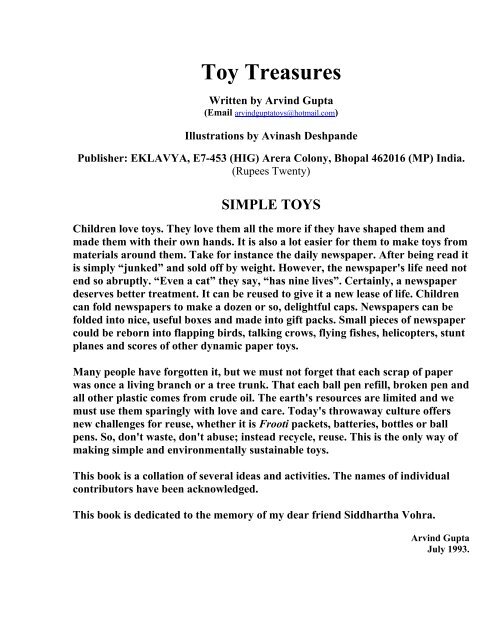
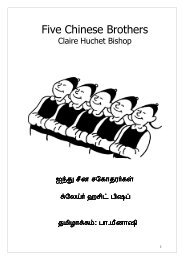
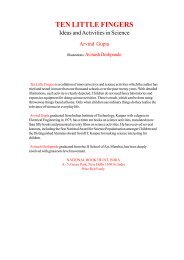
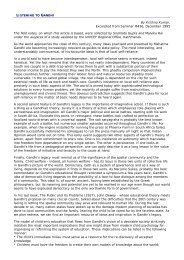
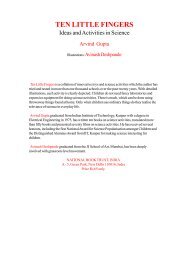
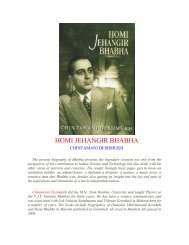

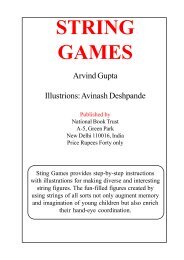

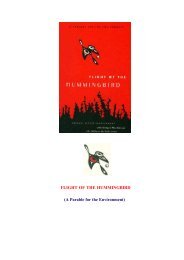
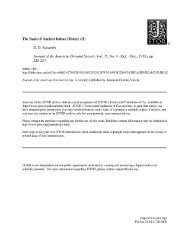
![tq,a] diM+s vkSj vk/qfud ekuo - Vidya Online](https://img.yumpu.com/31264147/1/190x245/tqa-dim-s-vksj-vk-qfud-ekuo-vidya-online.jpg?quality=85)

